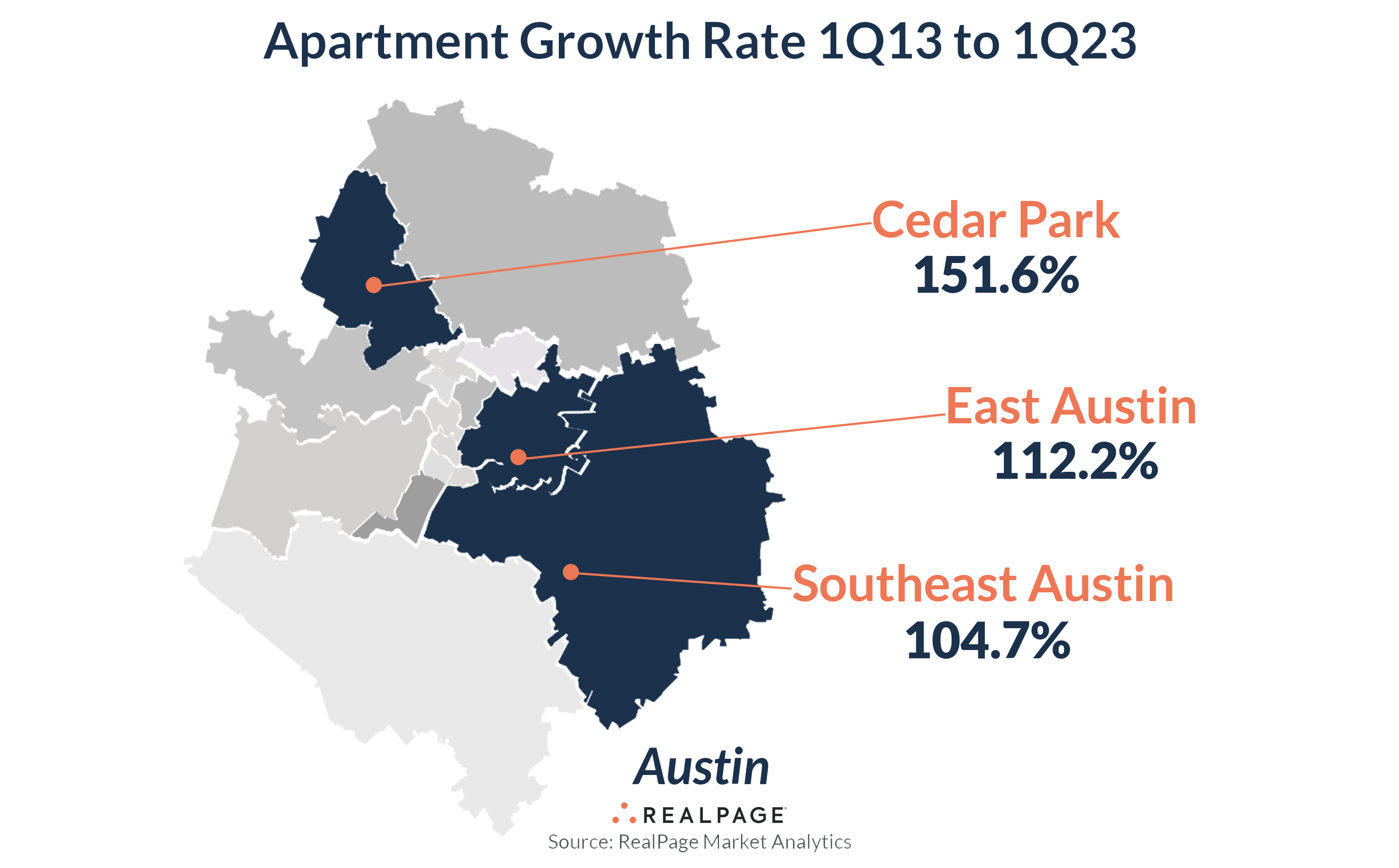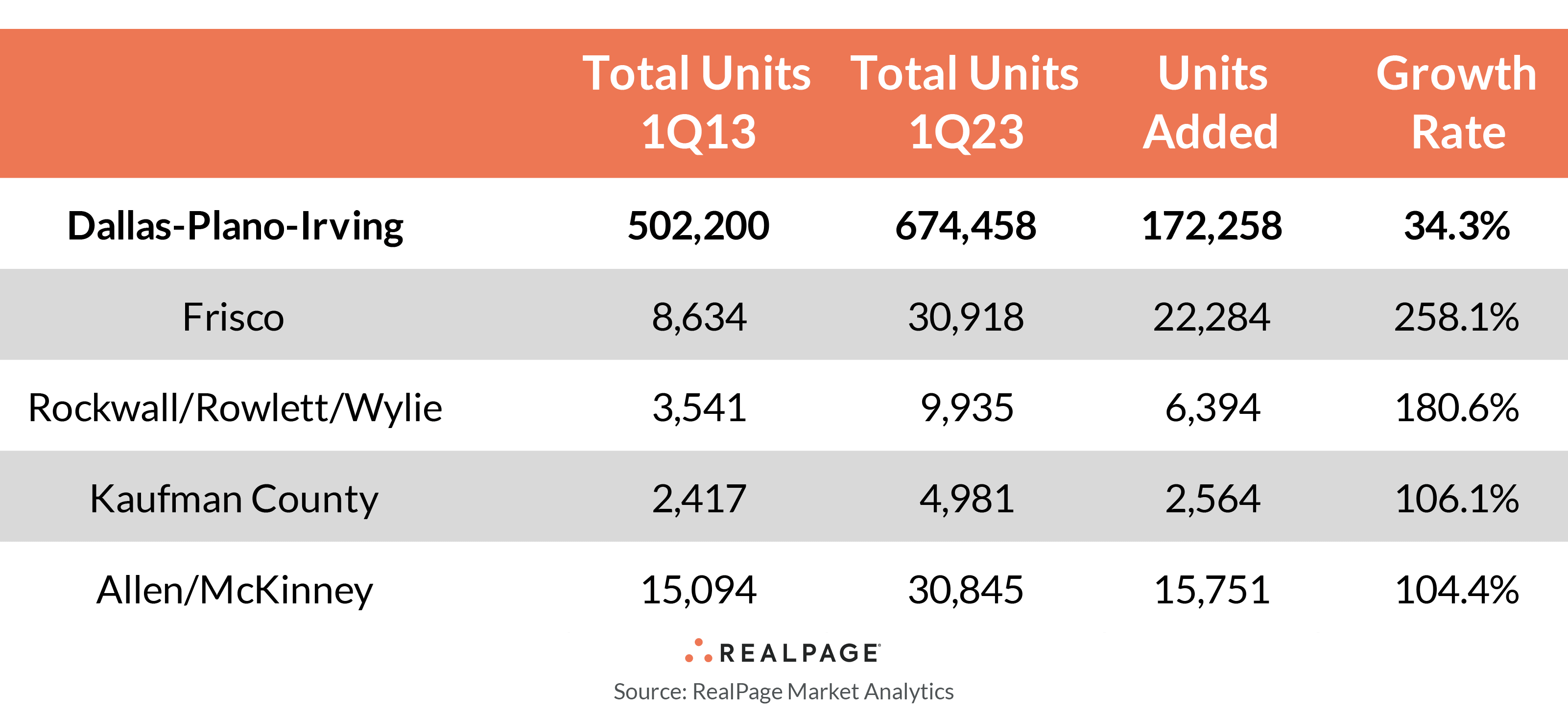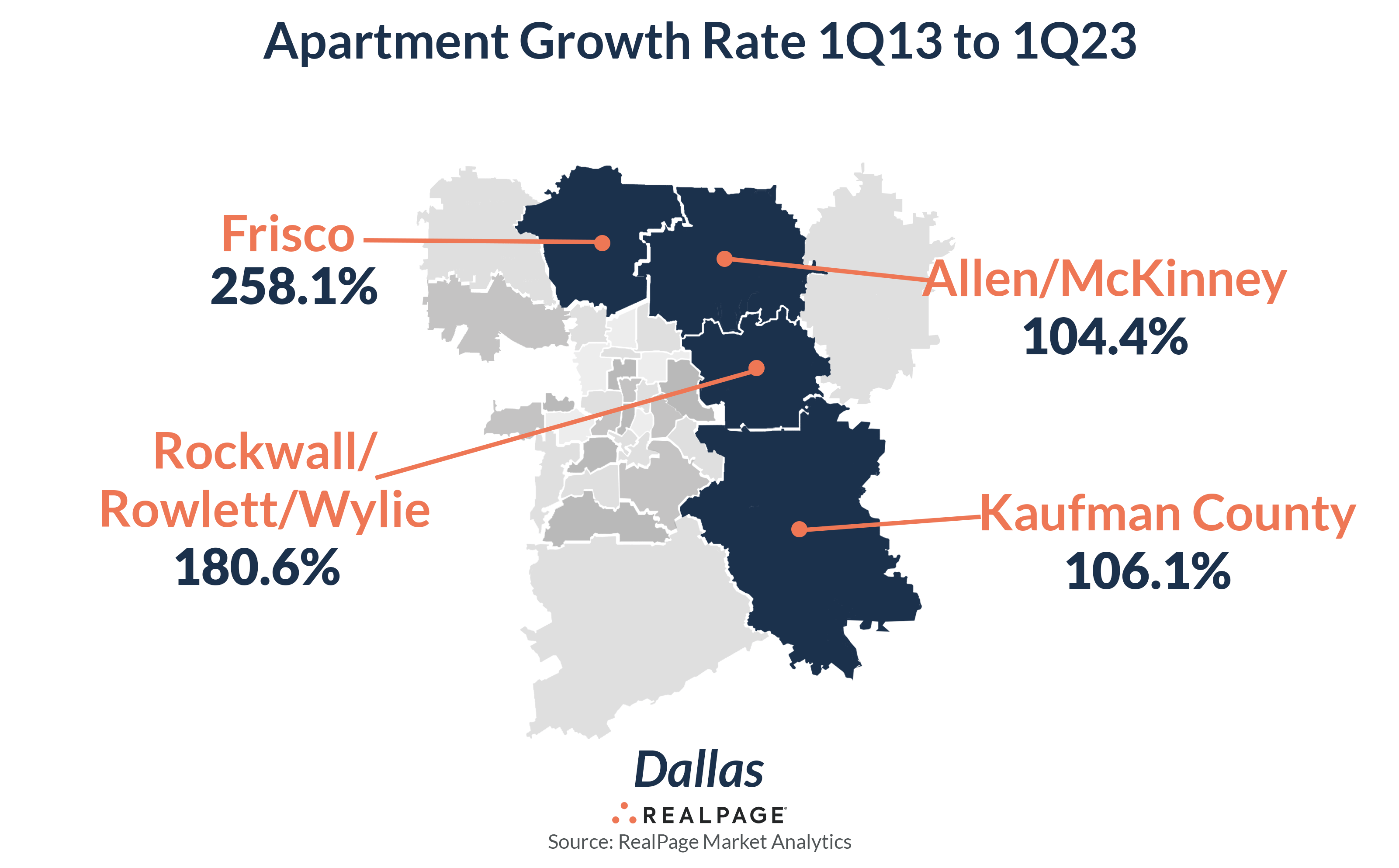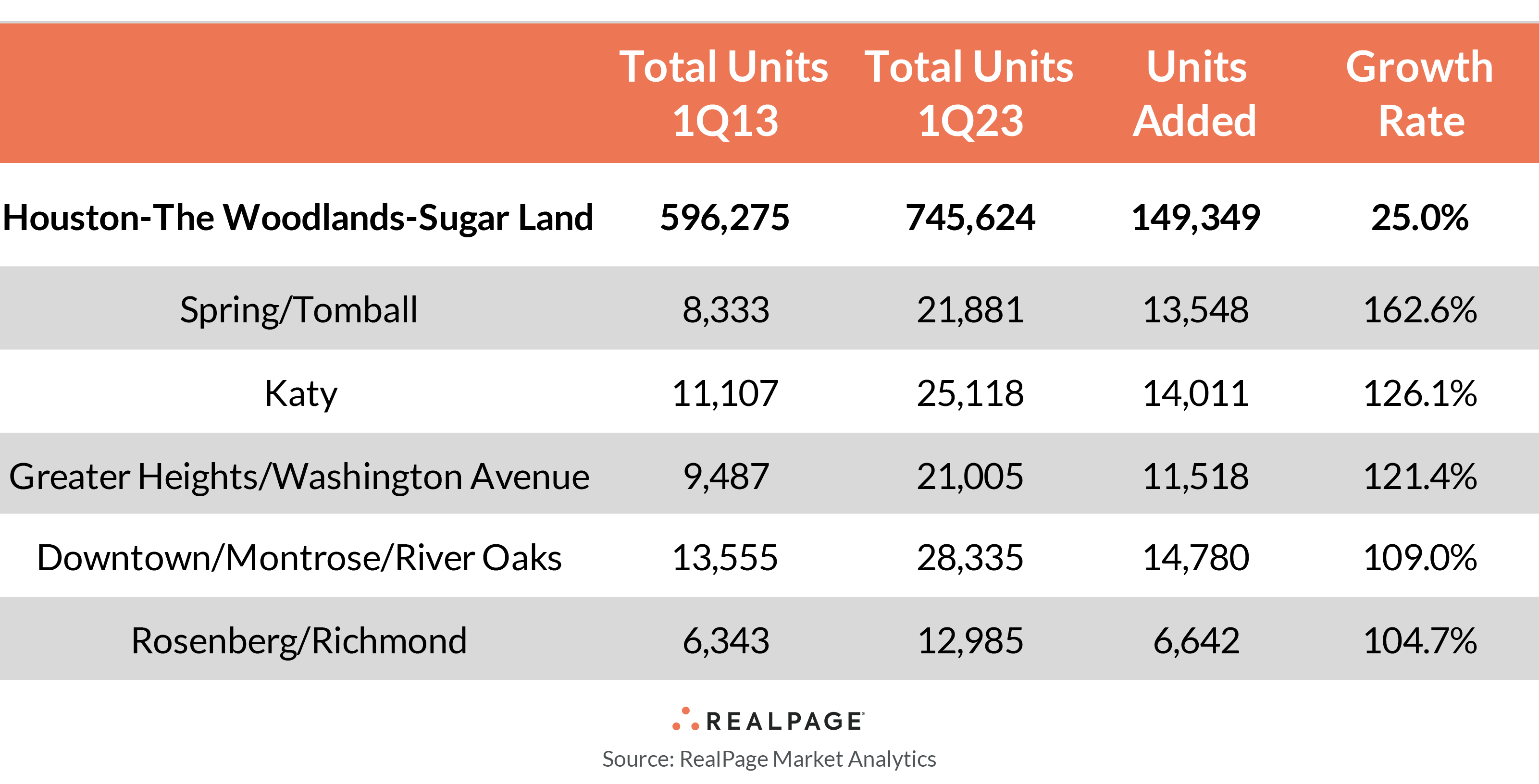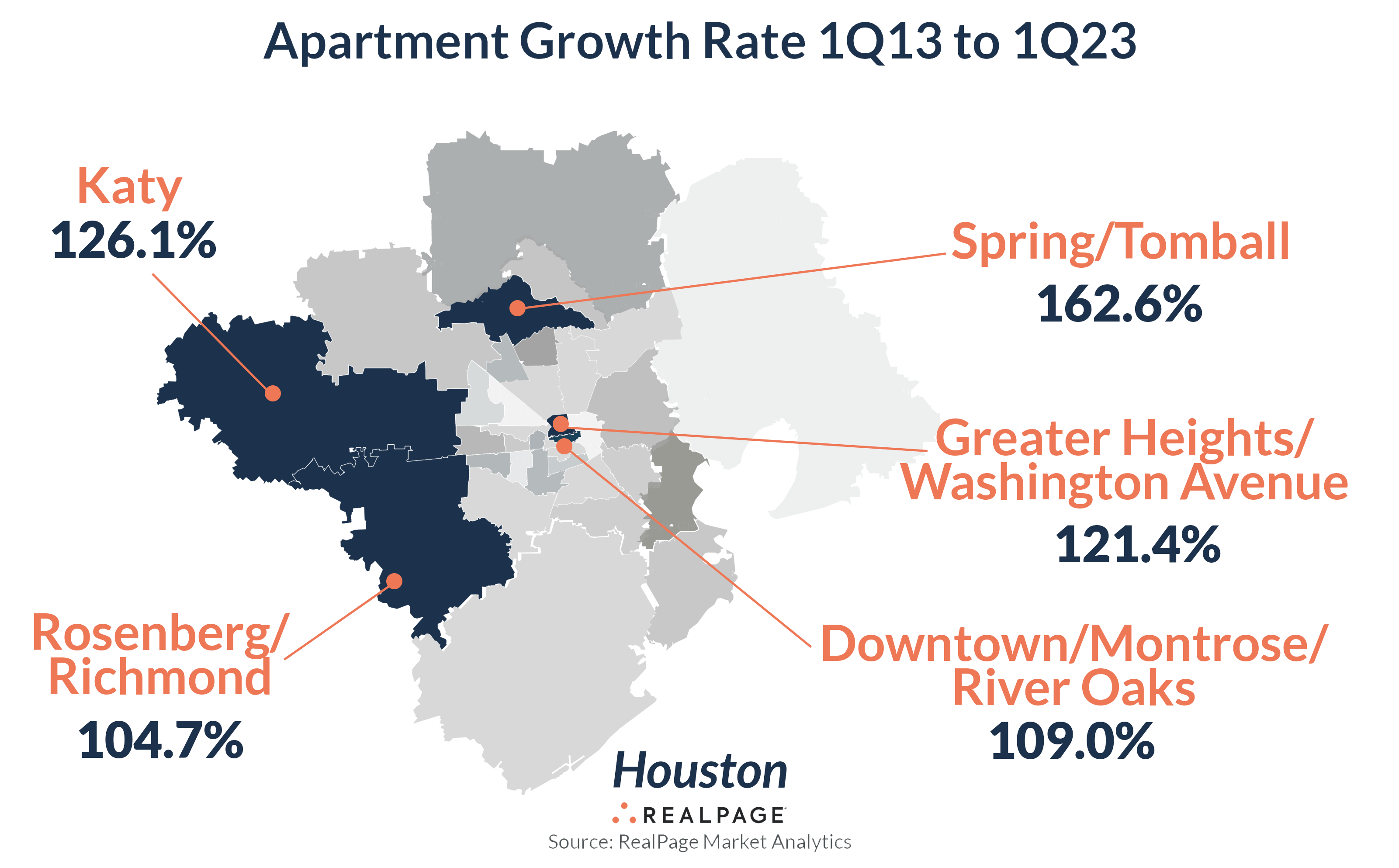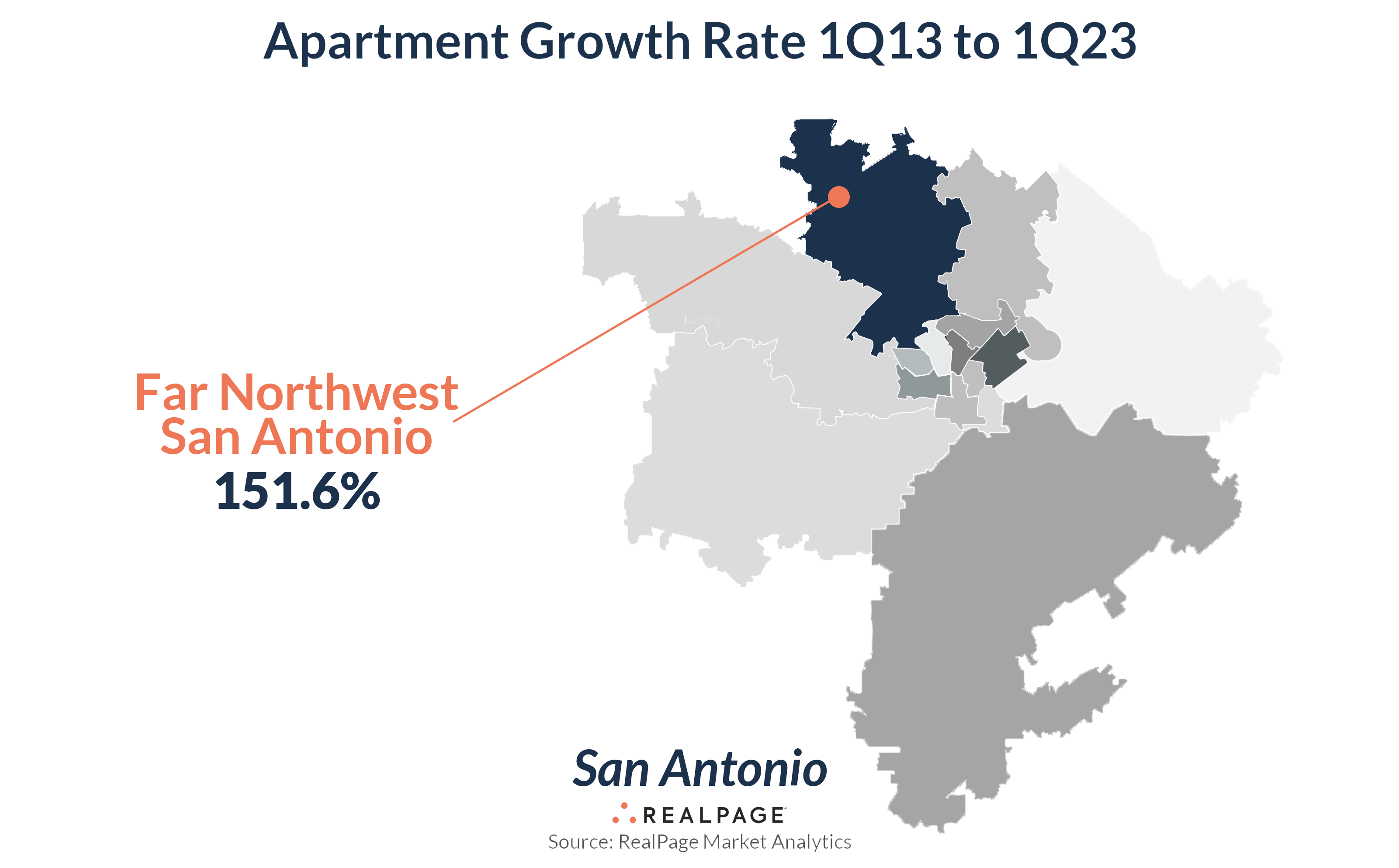Texas Neighborhoods Where Apartment Inventory Has Doubled in the Past Decade
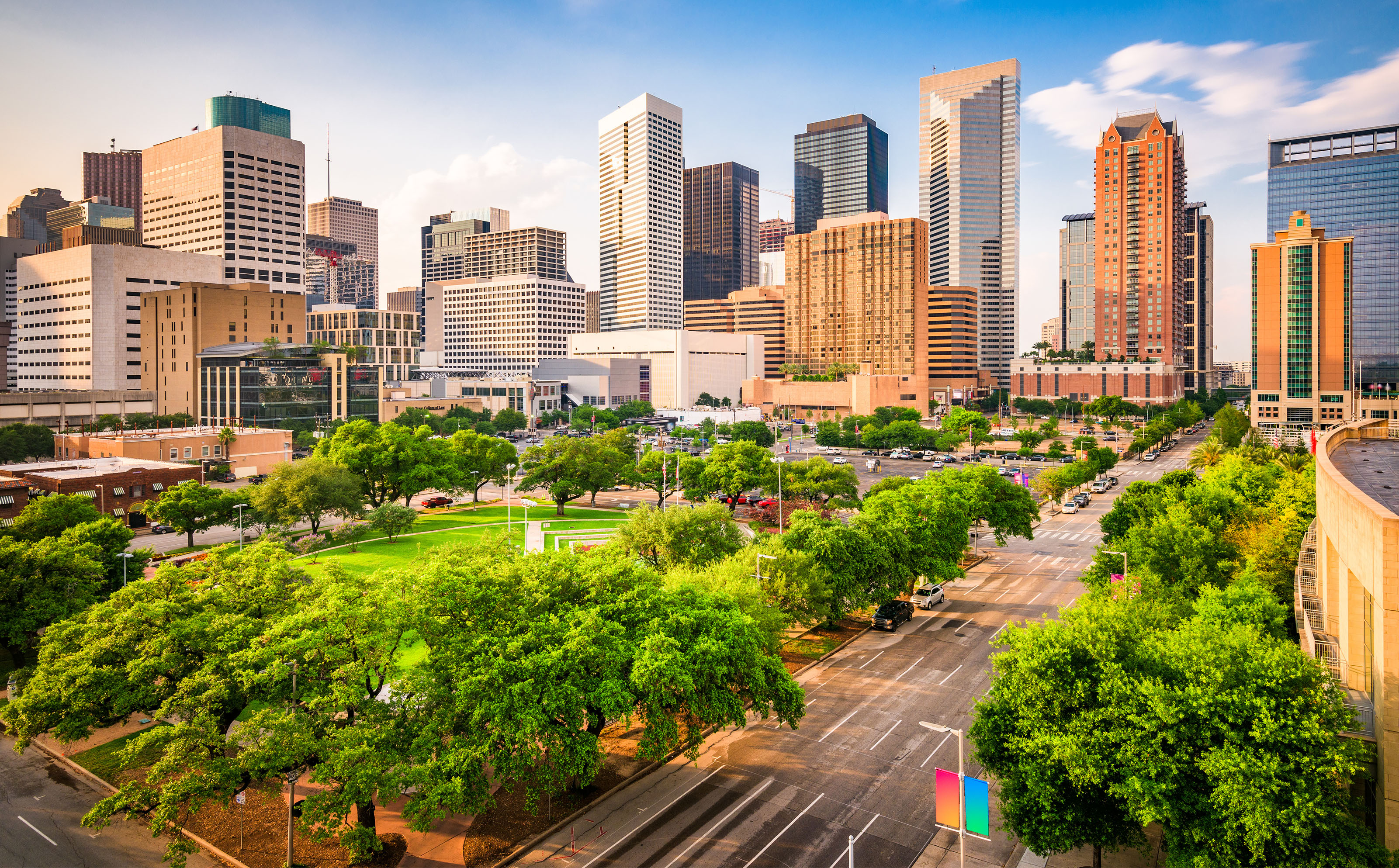
New apartment supply across the U.S. and Texas is booming. But there are areas that are on steroids. Some of the nation’s most significant apartment development activity has taken place in Texas and, of the 23 U.S. submarkets that have at least doubled in size over the past 10 years, more than half were in major Texas markets.
Across Texas, multifamily developers have delivered over 550,000 new apartment units in the last decade, equaling an expansion rate of 28.7%, according to data from RealPage Market Analytics. In several submarkets in Texas, however, that rate of inventory growth was far more prolific.
AUSTIN
Among the nation’s largest 50 apartment markets, Austin was the fastest growing in the last decade. The market added more than 96,000 units, on net, over the past 10 years, growing its inventory base 50%, according to data from RealPage Market Analytics. Of the 14 fastest-growing Texas submarkets, three were in Austin. Much of Austin’s growth has occurred along the US-183 corridor north of Austin, with Cedar Park capturing nearly 12% of the market’s new supply over the past decade. Meanwhile, East Austin captured nearly 13% of Austin deliveries, while neighboring Southeast Austin captured nearly 6% of new development.
Suburban Cedar Park had a little less than 7,400 apartments at the beginning of 2013 and by early 2023, this area had more than 18,500 units, after growing by 151.6%. Located roughly 16 miles northwest of Austin, Cedar Park is one of the only major suburban areas in the market with a commuter rail line, Capital Metro’s first and only rail line connecting to downtown Austin. Additionally, the area boasts its own concentration of employers. Drawn by employment options, people have been flocking to this area. The U.S. Census Bureau estimates that the Cedar Park population grew by roughly 16,000 people, or 26%, from 2012 to 2022. As of 1st quarter 2023, monthly rents in Cedar Park averaged $1,652, in line with the market average.
Another high growth area in Austin has been the neighboring submarkets of East Austin and Southeast Austin. These submarkets abut the IH-35 corridor, a development hotspot. East Austin is home to Tesla’s 2,500-acre Gigafactory that is producing 4,000 vehicles per week. Southeast Austin is the home to Austin-Bergstrom International Airport. East Austin has added over 12,000 apartment units in the past decade, growing 112%. Just in the past year, East Austin has grown by more than 13%, ranking as one of the biggest increases nationwide. Southeast Austin – the largest submarket by land mass in Austin – is one of the smallest based on the number of apartment units. That submarket had 10,905 units in early 2023, growing nearly 105% over the past 10 years. While monthly rents in East Austin ($1,738) were above the market average, rents in Southeast Austin ($1,532) remained more affordable.
DALLAS
The Dallas market added a nation-leading 172,259 apartment units over the past decade, resulting in an expansion rate of 34%. Those additions took the market’s existing unit count to 674,458 as of early 2023. Four of the nation’s fastest growing submarkets over the past 10 years were in Dallas. Much of the development has been to the north and east and includes areas along US-75, the Dallas North Tollway and IH-30. Allen/McKinney, Frisco and Rockwall/Rowlett/Wylie accounted for more than one-fourth of local apartment deliveries over the past 10 years. All three of those submarkets have monthly rents that run above the market average.
Frisco was not only the market’s fastest growing submarket in the last decade, but the nation’s as well. Frisco’s existing apartment base has expanded 258% since the beginning of 2013. Turning that percentage into an actual unit count, Frisco has received 22,284 new apartments since 1st quarter 2013. That represents 13% of all the new units added in the Dallas market over the past decade. The only submarkets nationwide to receive more units during that period were Brooklyn (29,418 units) and Jersey City (24,259 units) . Just in the past year, Frisco’s apartment base grew roughly 15%, the fourth-fastest growth pace nationally. The Frisco submarket is located on the northern side of Highway 121 (Sam Rayburn Tollway), bordered by Custer Road/Independence Parkway on the east, Lake Lewisville to the west and includes the city of Celina to the north. The Dallas North Tollway cuts up straight through the submarket. The Highway 121/Dallas North Tollway corridor is where office, retail and apartment construction are concentrated. With Frisco attracting major employers in recent years, its population ballooned 71% from 2012 to 2022 and now the city has nearly 220,000 residents, according to the U.S. Census Bureau. As of 1st quarter 2023, effective asking rents in Frisco were some of the priciest in Dallas, at $1,794 per month.
Neighboring northeastern suburban submarkets Rockwall/Rowlett/Wylie and Allen/McKinney have also seen notable growth in the past decade. Roughly 6,400 units were delivered in Rockwall/Rowlett/Wylie, resulting in inventory growth of over 180%, the third-biggest increase nationwide. Meanwhile, Allen/McKinney saw over 15,700 units delivered, one of the strongest increases nationwide. This inventory increased the existing apartment base by over 104%. The upscale Rockwall/Rowlett/Wylie submarket wraps around Lake Ray Hubbard, where lakeside shopping and entertainment options abound. A lot of the recent development here lines IH-30, which offers a direct route into downtown Dallas. Allen/McKinney is a more established submarket to the north, and most of the development here lines US-75, which also offers direct access to downtown Dallas. Average rental rates in these submarkets top $1,620 and are well ahead of the Dallas norm ($1,572).
While Kaufman County doubled in size in the past decade, this submarket remains comparatively small with a base of less than 5,000 apartments as of 1st quarter 2023. Nearly 2,600 of those units were delivered in the past 10 years. The rural submarket does, however, cover a lot of ground, spanning out to the east of Dallas, and includes the cities of Forney, Terrel and Kaufman. Development has lingered mostly in the northern portion of the submarket (which abuts the southernmost portion of Rockwall/Rowlett/Wylie), along US-80. Rents here remain just shy of the Dallas average, at $1,532, but have seen significant growth recently. Just in the past year, effective asking prices were up by 12.8%, which was more than double the Dallas average.
FORT WORTH
Fort Worth, Dallas’ neighbor to the west, added over 43,000 units during the past decade, growing existing stock nearly 24%. As of 1st quarter 2023, Fort Worth had 227,360 apartment units of inventory. Like Dallas, Fort Worth’s most active construction center has been to the north, primarily in the North Fort Worth/Keller submarket, accounting for one-fifth of Fort Worth’s inventory growth over the past decade.
North Fort Worth/Keller grew from around 6,400 units in early 2013 to just over 15,500 units in early 2023, growing 142% during that period. Just in the past year, North Fort Worth/Keller’s existing inventory grew 13%, the fifth-fastest growth pace nationally. North Fort Worth/Keller has been an attractive area for development due to easy access to downtown Fort Worth via IH-35, great school districts and proximity to employment hubs. AllianceTexas, the 27,000-acre master-planned community along IH-35 that overlaps the Lewisville/Flower Mound and North Fort Worth/Keller submarkets, has attracted many corporate businesses, industrial facilities and jobs. North Fort Worth/Keller asking rents are about the same as the fastest growing submarket in Dallas (Frisco), at $1,634 per month as of 1st quarter. Keller, the largest city in the North Fort Worth/Keller submarket, grew 8% from 2012 to 2022 to more than 45,000 residents.
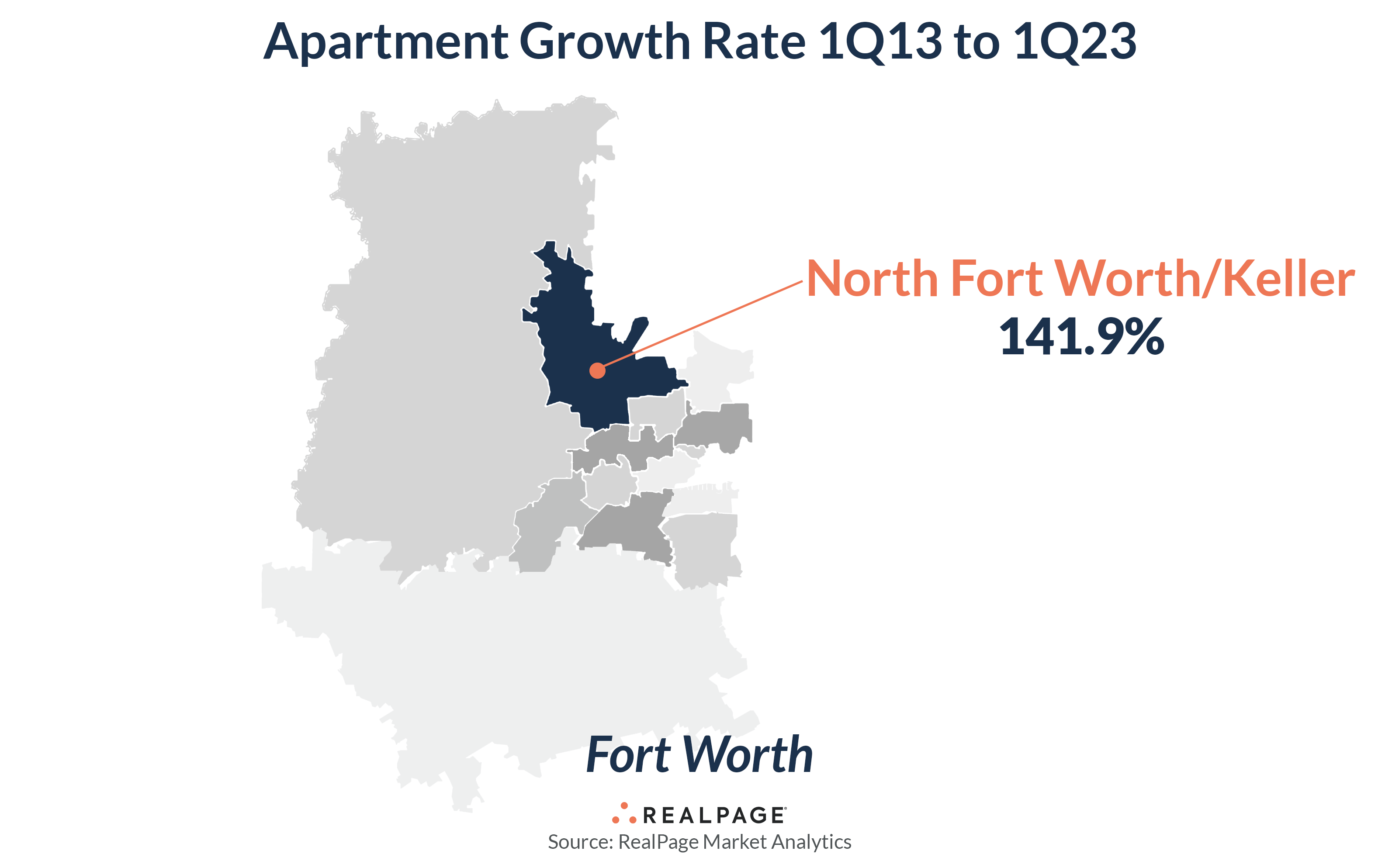
HOUSTON
Apartment additions in Houston totaled 149,349 units during the past decade, second in the nation to only Dallas. Those completions increased Houston’s existing apartment base 25%. Houston is home to five submarkets that have more than doubled in size over the past 10 years. Three suburban areas to the north and west have seen big growth, while two urban locales also generously increased.
Spring/Tomball added 13,548 units in the past 10 years, swelling the existing base by 162.6%, the nation’s fourth-largest increase. This northern suburban submarket offers two routes to downtown Houston, one via IH-45 and the other on TX-249, which eventually meets up with IH-45. Much of the recent apartment development has occurred between these two branches of transit. Average monthly rents here are just ahead of the Houston norm of $1,340, at $1,400.
The neighboring Katy and Rosenberg/Richmond submarkets are located along the west side of Houston. Roughly 14,000 units were delivered in Katy in the past decade, resulting in inventory growth of over 126%, while Rosenberg/Richmond saw over 6,600 units wrap up construction, increasing the submarket’s existing base by over 104%. These submarkets command rents ahead of the market average at roughly $1,400 to $1,500. These desirable suburbs have seen sizable growth in retail as well as housing in recent years. Katy enjoys a direct shot to downtown via IH-10, while Rosenberg/Richmond residents feed to Houston through IH-69. Each of these routes feature the biggest clusters of housing developments. From 2012 to 2022, the population in the city of Katy grew by 72% with the addition of 10,500 residents. Much of the growth in Rosenberg/Richmond occurred in Rosenberg, as that city added nearly 8,400 new residents from 2012 to 2022, growing its population 26%, while Richmond’s population grew less than 3%.
The urban centers of Houston have also seen big apartment supply, with Downtown/Montrose/River Oaks and Greater Heights/Washington Avenue capturing the bulk of completions over the past 10 years. While these two submarkets cover relatively small geographic areas, development is dense. Downtown/Montrose/River Oaks added nearly 14,800 apartment units over the past 10 years, growing existing inventory 109%. Meanwhile, Greater Heights/Washington Avenue, abutting Downtown/Montrose/River Oaks to the north, added around 11,500 units, an inventory expansion rate of 121%. With a large concentration of high-rise apartment buildings, Downtown/Montrose/River Oaks has the priciest rents in the Houston market, at $2,104 per month as of 1st quarter 2023. Greater Heights/Washington Avenue, primarily composed of mid-rise apartment buildings, had average monthly rents at $1,764, Houston’s fourth most expensive submarket.
SAN ANTONIO
As of 1st quarter 2023, the existing unit count in San Antonio stood at just over 222,100 units. That’s up by nearly 53,000 units since 1st quarter 2013, representing a 31% growth rate. More than one-fifth of San Antonio’s development activity during the past decade occurred in the Far Northwest San Antonio submarket.
Far Northwest San Antonio added nearly 12,000 apartment units over the past 10 years, growing its inventory nearly 105% during that period. This is a pricey suburban submarket, with average monthly rents running about $200 above the market average. The area is attractive for its Hill Country landscape and highly rated public schools. IH-10 links this area to big employers, passing through the neighboring Medical Center before connecting to downtown San Antonio. Far Northwest San Antonio is home to well-known master-planned communities such as The Dominion, Stonewall Ranch, La Cantera, The Rim and Cresta Bella. The submarket is also home to The University of Texas at San Antonio. Most of the submarket’s apartment construction has occurred along IH-10, from Boerne to Fair Oaks Ranch and down to Loop 1604. Boerne has seen its population grow 79% from 2012 to 2022, to more than 20,700 residents. And Fair Oaks Ranch has grown 57% from 2012 to 2022 to around 11,100 people, Census data shows.








